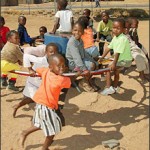“Troubled Waters” – PlayPump
 The PlayPump system first gained significant attention in 2005. The concept involves devices similar to merry-go-rounds, which are installed near schools in Southern Africa. The spinning of the device powers a pump, which brings fresh water up from the ground. Excess water can be stored in an overhead tank. Furthermore, the system pays for itself in advertising. In 2006 the United States pledged $10 million to support the project.
The PlayPump system first gained significant attention in 2005. The concept involves devices similar to merry-go-rounds, which are installed near schools in Southern Africa. The spinning of the device powers a pump, which brings fresh water up from the ground. Excess water can be stored in an overhead tank. Furthermore, the system pays for itself in advertising. In 2006 the United States pledged $10 million to support the project.
It seemed like a beneficial situation, and it was for some time. However, eventually a number of problems began to arise. Frontline of PBS ran a story covering the PlayPumps. This episode dates from last year and chronicles some of the problems that have been encountered with the system.
The overarching argument could be that too much was done too fast, and that it was assumed that extreme success in one circumstance automatically guarantees moderate or even marginal success in other situations.
PlayPumps were first installed in schools in South Africa. In that region there was an ample supply of children who could easily pump water from the ground. These pumps were also geographically located close to the main production facility in Johannesburg and along lines of relatively good communication. This was not the case for pumps located in much of Mozambique. Many pumps were placed in rural locations, and were used incorrectly and inefficiently, mainly by the women of the village. Once a pump breaks, it can be out of order for a year or more.
One of the main causes is almost certainly the growth of bureaucracy. The PlayPump was initially a rather small charitable organization, localized in South Africa and capable of effectively overseeing installation and maintenance. Part of the issue is that many of the pumps are now being installed by other organizations. One such organization is Save the Children, which is located in Mozambique. With less oversight, the locations where pumps are placed are not being properly tested, and thus pumps run dry quickly. In other cases, older hand pumps are replaced without consulting the local community.
Furthermore, PlayPumps is now headquartered in Washington D.C., and is working with more organizations, such as Unicef, which are far removed from the production facilities and offices in Johannesburg. PlayPumps are now being installed in over ten states in Southern Africa, and the organization had a 4,000 pump goal in 2010.
Despite this goal, the production of the PlayPumps came to an end late last year. What was seen as such a brilliant idea eventually became, to the disappointment of many, rather limited utility. The remaining inventory will be used only in limited circumstances. Unfortunately there is no one-size-fits-all solution. The best of intentions can go very wrong.
It is only rational to think that in order to have water one only needs a pump and that there are no drawbacks. However in reality every situation is different and needs to be handled individually and uniquely, and therein lies perhaps the greatest unrealized development challenge.
http://www.pbs.org/frontlineworld/stories/southernafrica904/video_index.html
By Gregory Weeks
